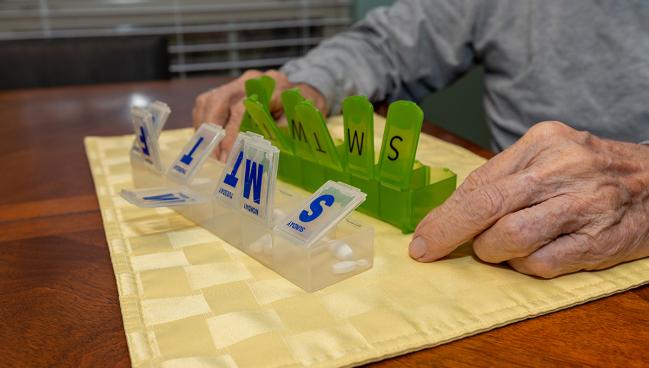Ezetimibe Plus Moderate-Dose Statins May Aid Compliance in the Elderly
This subanalysis of the RACING trial suggests older patients with ASCVD may do better on this regimen than on high-dose statins.

Compared with standard high-dose statin therapy, combination therapy with a moderate-intensity statin plus ezetimibe seems to reduce the risk of cardiovascular events to a similar degree over 3 years in an elderly patient population, and may improve compliance, according to a post-hoc analysis of the RACING trial.
That study, as reported by TCTMD, showed that the ezetimibe-based combination therapy could be a good option for those with apparent side effects from stronger statin doses in patients with atherosclerotic cardiovascular disease (ASCVD) needing to reduce their LDL cholesterol.
This substudy was important to conduct because elderly patients often have been excluded from previous clinical trials of intensive lipid-lowering therapy, senior author Jung-Sun Kim, MD, PhD (Yonsei University College of Medicine, Seoul, Korea), told TCTMD in an email.
These results, he continued, have already influenced his practice: he now prefers to use moderate-intensity statins in combination with ezetimibe therapy “over high-intensity statin monotherapy, especially for elderly ASCVD patients who have experienced statin-related side effects, as well as those with impaired glucose tolerance such as HbA1c level between 6.0% and 6.5%.”
For Arman Qamar, MD, MPH (NorthShore University Health System, Evanston, IL), who was not involved in the study, the findings make sense. “Over the course of the last few years after the IMPROVE-IT, FOURIER, and ODYSSEY data [came] out, almost all physicians across the United States now believe in what is called the ‘LDL hypothesis,’ which is that it is really the LDL that matters. It doesn't matter what drug you use,” he told TCTMD. “For now, I am still using statin therapy first. However, it is likely that based on this study, in an elderly population, I might for any patients who are concerned themselves or if they have mild side effects, perhaps add ezetimibe sooner.”
Elderly Results
For the study, published online ahead of the April 11, 2023, issue of the Journal of the American College of Cardiology, Sang-Hyup Lee, MD (Yonsei University College of Medicine), Kim, and colleagues included the 574 patients (15.2%) with ASCVD who were 75 or older from the main RACING trial population. Compared with the rest of the trial population, patients in the elderly group were more likely to be female, had lower BMI, and were more likely to have a history of previous CABG, cerebrovascular accident, and predisposing comorbidities like hypertension and chronic kidney disease.
Similar to the main study results, the rates of the primary endpoint—a 3-year composite of cardiovascular death, major cardiovascular events, or nonfatal stroke—in the elderly cohort were similar for those who received moderate-intensity statins with ezetimibe and those who were treated with high-intensity statin monotherapy (10.6% vs 12.3%; HR 0.87; 95% CI 0.54-1.42).
Rates of that primary outcome in this older population were similar to those younger than 75 years (8.8% vs 9.4%; HR 0.94; 95% CI 0.74-1.18).
Importantly, however, the combination of moderate-intensity statins and ezetimibe was associated with lower rates of intolerance-related drug discontinuation or dose reduction compared with high-intensity statin monotherapy among patients in the elderly group (2.3% vs 7.2%; P = 0.010) and in those younger than 75 (5.2% vs 8.4%; P < 0.001; P for interaction = 0.159).
Notably, median LDL cholesterol levels remained consistently lower for elderly patients in the ezetimibe combination group compared with those receiving high-dose statin monotherapy at year 1 (59 vs 63 mg/dL; P = 0.004), year 2 (58 vs 62 mg/dL; P = 0.013), and year 3 (57 vs 64 mg/dL; P = 0.036). Also, the rate of new-onset diabetes was lower for the former compared with the latter treatment group (10.0% vs 18.7%; P = 0.025), and there was a significant interaction noted compared with the under-75 group for this endpoint (P for interaction = 0.041).
Kim said that none of the results were surprising to him, but it was important that the elderly subgroup was the only one to demonstrate a difference regarding new-onset diabetes, adding to this being an “attractive strategy for elderly patients with ASCVD.”
For him, the main advantage of moderate-intensity statin with ezetimibe combination therapy “is similar efficacy with less concern for safety issues at the same time,” he said. Prescribing a moderate-intensity statin with ezetimibe might lead to additional cost, he acknowledged. “However, this may vary according to country and site.”
Future Research
In an accompanying editorial, Christie M. Ballantyne, MD (Baylor College of Medicine, Houston, TX), and colleagues write that the findings from this subanalysis “suggest similar clinical efficacy in event lowering and superior LDL cholesterol-lowering with a favorable side effect and safety profile.”
However, they point out, “this analysis was underpowered for the subgroup aged > 75 years, and individuals aged > 80 years were excluded from the original study design, limiting the conclusions and generalizability of findings in the elderly population.”
While these findings, along with IMPROVE-IT and EWTOPIA 75, suggest that ezetimibe might be a good treatment option for elderly patients, “future studies, including pragmatic trials, should go beyond focusing only on the efficacy of new lipid-lowering therapies and test the effectiveness of different approaches to implement lipid-lowering therapies in this very important high-risk population,” they conclude.
Qamar added that he would like to see how the ezetimibe combination therapy tested in this trial would fare against newer agents like inclisiran monotherapy, which is injected only once every 6 months. “In this patient population, compliance, polypharmacy, all of that [are] issues,” he said. “So perhaps can we just cut down one pill and improve compliance? . . . The chance to achieve compliance is profound.”
Assuming the ongoing ORION-4 trial supports an impact on clinical outcomes with inclisiran, Qamar predicted that the therapy is likely to change treatment options over the next decade. “I think this field will keep improving,” he said.
Yael L. Maxwell is Senior Medical Journalist for TCTMD and Section Editor of TCTMD's Fellows Forum. She served as the inaugural…
Read Full BioSources
Lee S-H, Lee Y-J, Heo JH, et al. Combination moderate-intensity statin and ezetimibe therapy for elderly patients with atherosclerosis. J Am Coll Cardiol. 2023;81:1339-1349.
Ballantyne CM, Varughese MG, Abushamat LA. Lipid-lowering therapy in the elderly: are current guidelines a sign of ageism in medical care? J Am Coll Cardiol. 2023;81:1350-1352.
Disclosures
- Hanmi Pharmaceutical, Seoul, Korea, funded the study.
- Jung-Sun Kim reports receiving proctoring fees from Abbott Vascular.
- Ballantyne reports receiving grant/research support through his institution from Abbott Diagnostic, Akcea, Amgen, Arrowhead, Esperion, Ionis, Merck, Novartis, and Regeneron; serving as a consultant for Alnylam Pharmaceuticals, Althera, Amarin, Amgen, Arrowhead, AstraZeneca, Esperion, Illumina, Matinas BioPharma Inc, Merck, New Amsterdam, Novartis, Pfizer, Regeneron, and Roche Diagnostic; and receiving consulting fees from 89Bio, Abbott Diagnostics, Alnylam Pharmaceuticals, Althera, Amarin, Amgen, Arrowhead, AstraZeneca, Denka Seiken, Esperion, Genentech, Gilead, Illumina, Matinas BioPharma Inc, Merck, New Amsterdam, Novartis, Novo Nordisk, Pfizer, Regeneron, and Roche Diagnostic.
- Lee and Qamar report no relevant conflicts of interest.





Comments